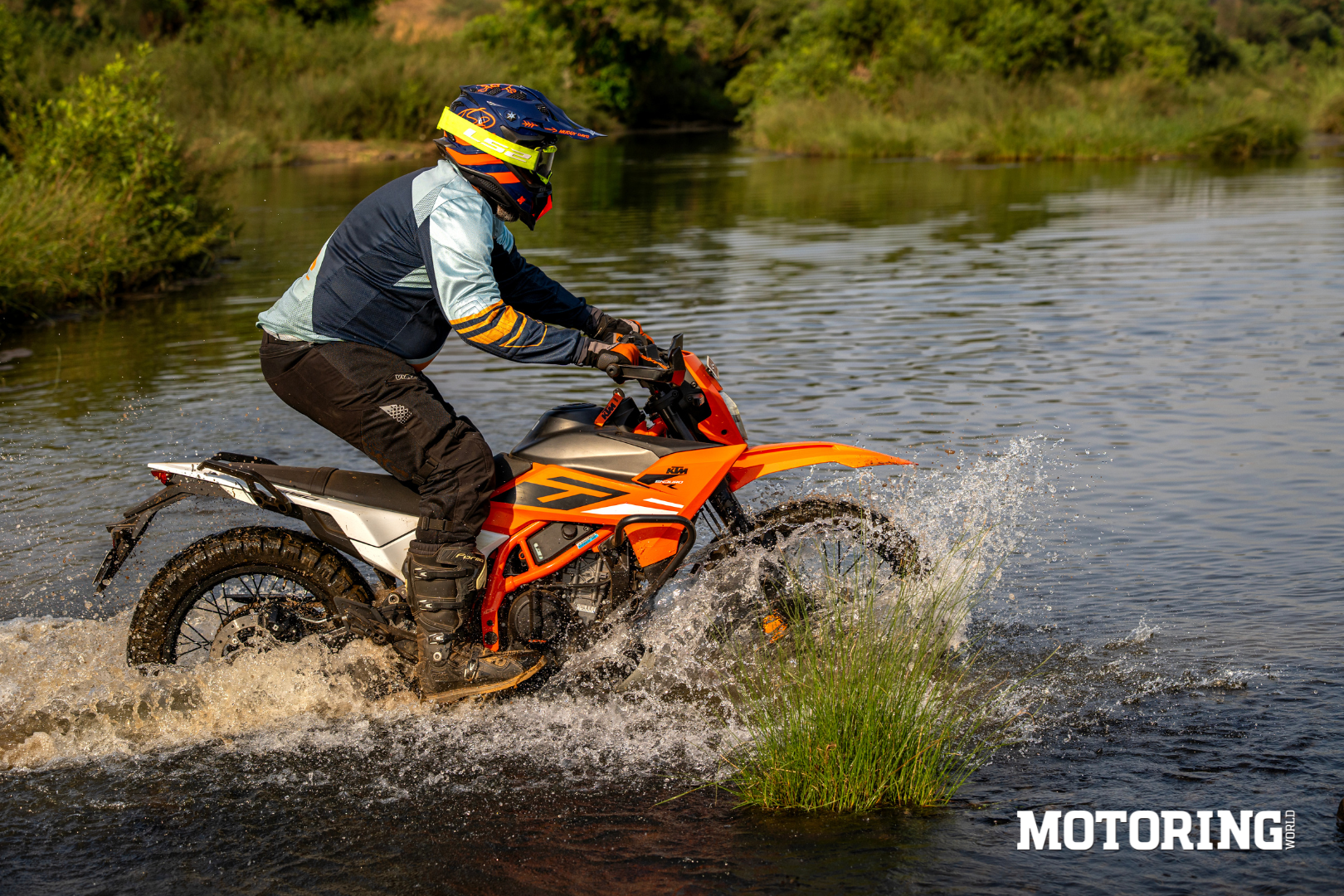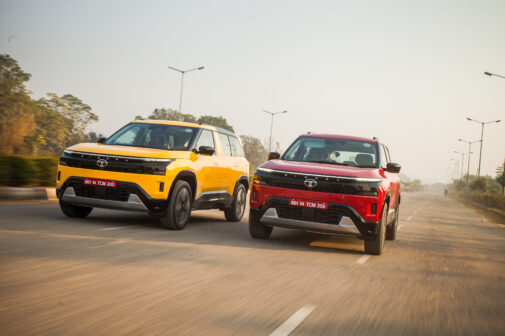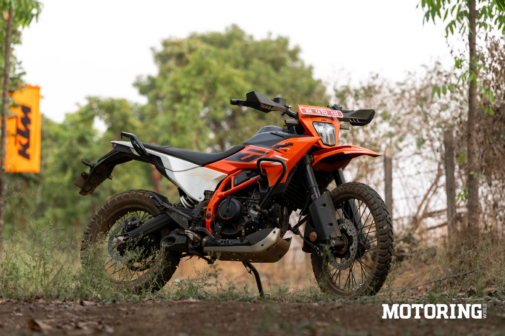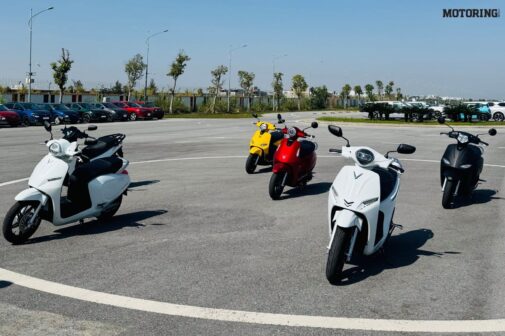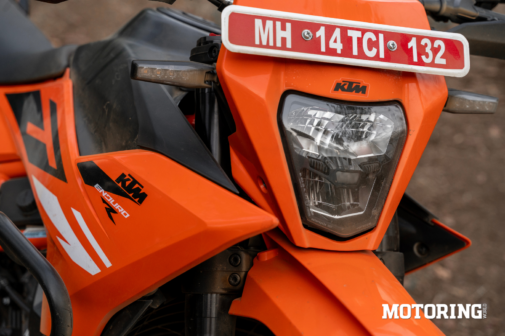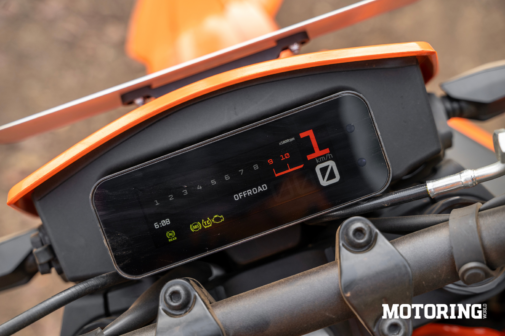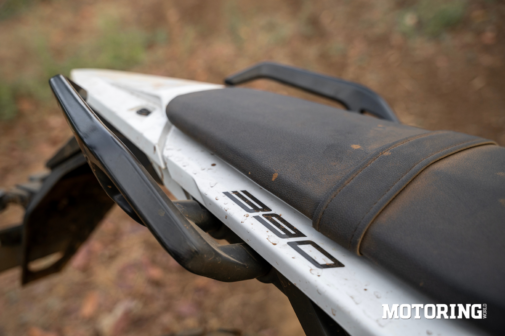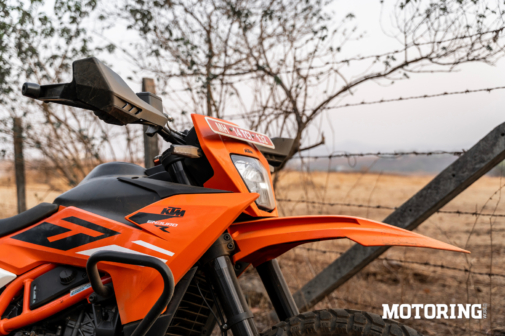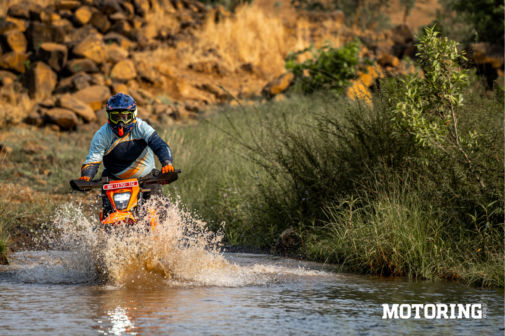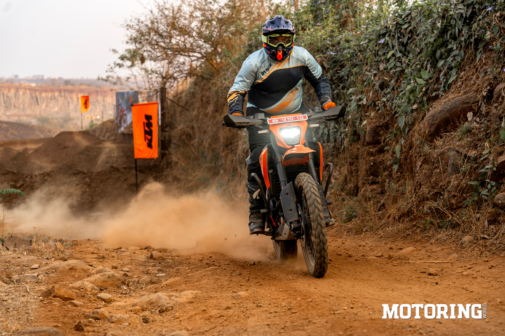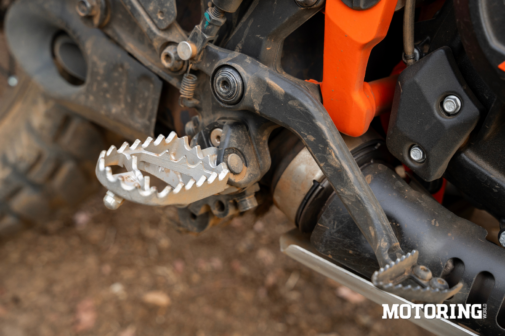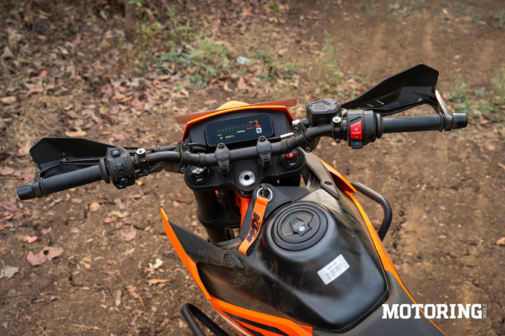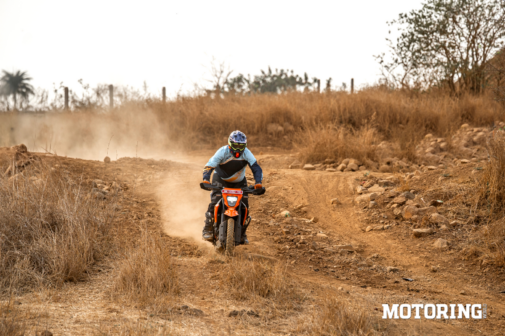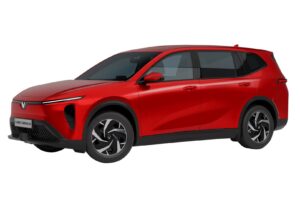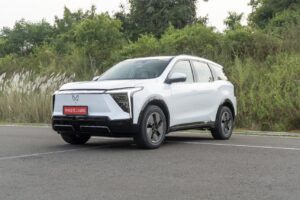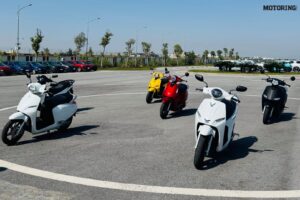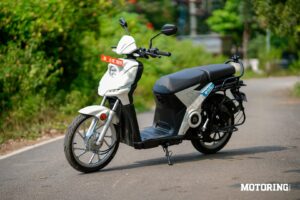It says something about us when you note how it’s taken KTM 13 years to launch, in India, the kind of motorcycle that best represents its pedigree. To give you context, KTM had only been making Dukes for 18 years before it launched one in India. The RC series of faired sportbikes? Six; the RC-8 only came about in 2008. It has been making off-road bikes since 1953, though — a small matter of 72 years, that is. India, meet the real KTM, at last!
It was a tough wait for us but, surely, equally so for KTM. Because while KTM makes some unforgettable motorcycles across categories, its off-road motorcycles are unapologetically dominant. How else do you explain KTM’s kitty of over 340 championship titles in the last 72 years? With that sort of pedigree, KTM had no choice but to get its first road-legal enduro for India spot-on. The biggest yardstick it had to measure up against was its own, after all.
R YOU FOR REAL?
Almost immediately, there happens to be a digital elephant in the room with the Internet ranging between disappointment and fury over the ‘R’ suffix. Let’s get right to it. You see, unlike the global-spec Enduro R, the Indian R gets lesser suspension travel (200 mm/205 mm instead of 230 mm/230 mm, front and rear respectively) and this has, understandably, upset a lot of people. Fair enough, too, seeing how each of its benchmates — the KLX 230, XPulse 210 and even the Himalayan — offer more or as much in this department. Considering KTM manufactures the Enduro in India, it is thankfully not a matter of engineering but of economics. At the time of filing this story, KTM is working out the details of selling the international-spec bike in India, which should see the suspension travel, ground clearance and seat height be restored. Whether KTM decides to offer this spec as a variant or as à la carte paid upgrades remains to be seen and we will update this story once the final details are out. Come, let’s meet the 390 Enduro R now.
It’s a cool, instantly desirable motorcycle and, perhaps, the first beautiful motorcycle KTM has placed on a shelf in India. Everything that precedes it owes its popularity to function and performance; the 390 Enduro is a pleasant exception. Call me biased, though, seeing as I spent my formative years riding a friend’s KTM 250 EXC-F which, therefore, makes me subscribe to the 390 Enduro R for pure nostalgia. Either way, it’s not a bike that’s polarising or offensive, unlike a few others in KTM’s line-up. I’ll call it the KTM equivalent of a pair of blue jeans you can’t go wrong with.
WANT TO LOOK CLOSER?
If you do, you’ll find that the rider’s interface is delightfully minimalist, with a slim 4.2” TFT display that tucks in neatly behind the masked headlight and uncomplicated switchgear on either end of the handlebar. To the right, you have an engine kill switch and starter and on the left (starting furthest away from you) you get a headlight flasher/high-beam trigger, a prominent ABS button, an easy 4-way joystick and a button for the horn. KTM has equipped it with a C-type USB port but it wasn’t in plain sight and I wasn’t interested in looking for it either — phones stay in bags, for me. There’s Bluetooth connectivity on offer, too, (turn-by-turn navigation and music) features that, for me, remained blissfully unexplored. The switches feel robust and well-finished although I’d have liked the joystick to relay some tactical feel, even as it goes about doing what it’s meant to with ease. The screen is a smart little unit with a bonded glass top and it gets you all the essential readouts using a simple layout. The primary display tightly stacks together the speedometer, gear position indicator and a horizontal bar for a tachometer, aside from which are a set of tell-tale lights. One step into the menu gets you trip data and you can further use the joystick to switch between the two riding modes (Street and Off-Road) or to configure them to your liking. There’s also a ‘reduced’ display on offer, which leaves you with just the speedometer and the gear indicator but, since I’m new to this generation of the 390’s engine, I preferred to stick with the full display, to be able to monitor the revs.
GRAB A SEAT
As a 6-footer, I was able to simply swing a leg over the seat — set at a height of 860 mm — before proceeding to place both of my feet flat on the ground. On uneven ground, with a tail bag mounted (as I had), it’s best to step on the left footpeg and then swing your right leg over your luggage. The seat itself is slim (not dirt-bike slim, fortunately) and its narrow aperture is what enables even those measuring 5’10” to flat-foot, with shorter riders progressively shifting towards their toes. If you’re 5’6” or shorter, a little planning may help you mount the bike safely, especially if you’re in an off-road environment. But considering you got there in the first place, it poses no great contest.
Hereafter, it’s a series of favourites. I love the tall riding position, where you’re able to see the tip of the beak and, in general, above most of the traffic you’ll pass in a blur. The handlebar is a different unit to the one on the Adventure and it feels comfortably wide, giving you ample leverage. It also features taller risers than on the Adventure, better suited to stand-up riding, and even offers adjustability, in that you can move it slightly fore or aft if you prefer. It’s the same story with the serrated footpegs which come with chunky rubber tops and can be adjusted (using tools, of course) to move up by roughly 10mm or so. For my hefty frame, the factory settings felt perfectly fine, both, on and off the road.
START WHERE THE ROAD ENDS
My time with the Enduro began, of course, off the road. KTM had chalked out an hour-long trail over which a bunch of other scribes and I were to familiarise ourselves with the Enduro. I can’t say I was particularly excited about this arrangement at first because too many new things (bike, people, terrain) can stir up needless dramatics but, nevertheless, I played along. The Enduro gets off the line super clean, its responses conveying no sloppiness. The clutch feels light, the throttle has a good feel to it and, within the first minute, we were gliding over a dusty, lunar crater-ish surface. I’ll admit, I went in expecting something very different. I thought the Enduro was going to be unwieldy — fast, but with hardly any manners — but it’s nothing of the sort. It’s refined, it’s progressive and it’s, for the most part, predictable. Dare I say it, this might just be the best 390 of them all. Yet.
Over the course of the trail, we rode down steep slopes, powered through a tricky section lined with stones, scaled pretty intimidating-looking inclines and waded through a shallow but unsettling stream. That it was a cruelly hot day didn’t help but, here’s a fact, we all made it through incident-free — without so much as a tumble, even. The Enduro showcases impressive flexibility, whether you’re struggling or going flat out, thanks to the 3.9 kgm of torque its 399cc engine generates and that if offers a low-speed crawl function certainly makes its case stronger. I clearly felt under-skilled and unfit (because, well, I am) through most of the course but the Enduro, with its adaptability and manner of responses — and its 177-kg kerb weight — ensured I had a lot of fun astride it. Halfway up the trail, I was taking liberties I didn’t think I was going to, laying down most of its 45.3 bhp on dirt but the Enduro, while sometimes getting dramatically sideways, just kept rising to the challenge. Its threshold, clearly, is way above my own. And I’ve been riding off-road since I was 15!
Its 253-mm ground clearance certainly felt ample, too; I didn’t find an opportunity to miss the 20 mm it has lost over the international-spec version and while I quite fancy an 890-mm seat height, the existing one (860 mm) worked perfectly fine, with the seat-footpeg distance thankfully being spacious enough to not cause any discomfort. In fact, the relatively lower seat proved to be an advantage when I lost balance crossing the stream, being able to hold the motorcycle more or less upright while my feet looked for firm ground. At this point, I must also bring up the Mitas Enduro Trail+ tubed tyres (90/90-21, 140/80-18; front and rear) which did as asked although there’s better, softer rubber up for grabs in the aftermarket. Of course, for off-road use, it’s advisable to drop tyre pressures; KTM had dropped tyre pressures to 18 psi (16, on some bikes) while stock pressures are 29 psi at either end. I did feel a 130-section rear would have made the Enduro a little more dramatic although it may have compromised the ride quality to some extent.
TYRE TALK
Why not tubeless tyres, though? KTM says tubeless tyres aren’t as good as absorbing tough terrain and can, in extreme cases, lead to bent rims thereafter making your motorcycle unrideable. Indeed, KTM’s entire Enduro range, which consists of everything from 125cc two-strokes to 500cc four-strokes, features this exact spec so, you can say, it’s sound logic. Except, it isn’t, because the 390 Enduro R is a road-legal bike and not all of us own pick-up trucks or live next-door to a trail. For all of your off-road ambitions, you’re still going to spend serious tarmac hours and, on a 150+ kph bike, a tyre blowout can prove disastrous. KTM has, thankfully, responded promptly to this collective concern and is likely to offer tubeless tyres (although likely with a 17-inch rear) as a paid extra. Sure, it will eat into a sliver of the Enduro’s off-road capability, but it’s best if KTM left it to us to make that choice, right?
ONE FOR THE ROAD?
Where can you realistically do 150 kph on an Enduro R, though? Everywhere! It may have lost just the tip of its top end as compared to the Adventure courtesy its 48-tooth rear sprocket (the ADV gets a 46 rear) but the Enduro is a fast bike all right! In fact, referring to notes from Kartik, I’ve learned that the Enduro feels even more alive than the ADV and, for sure, the build-up of speed feels more pronounced given that there’s no visor to obstruct air-flow to the rider. While it is a seriously quick bike it also, amazingly, adapts very well to cruising. You get to 100 kph in 6th with the revs hanging around at 5500 rpm; 120 kph sees the revs rise to 6500 rpm, at which point the Enduro is still in its comfort zone — never mind the light but consistent vibrations (slight buzz at the handlebar and footpegs) which, to me, aren’t deal-breakers at all.
Given that it’s an enduro, it’s not meant to be scalpel-like — not in a conventional way, at least. With enough saddle time, you’ll find an aggressive way through corners, but it won’t look like the sort of thing you’d do on, say, a Duke. The Enduro is decidedly measured in its responses to steering inputs and, in traffic, you’ll perhaps scan the road a bit more patiently (helps that you can see over roofs of cars) before committing to lane changes. It still offers fast progress and — I have no doubt about this — you’ll probably average much higher speeds than everyone else around you.
Credit for that goes equally (or more, in fact) to its fantastic suspension. The USD fork/monoshock units are carried forward from the Adventure although they have been tuned differently to suit the Enduro. The fully-adjustable front suspension does a brilliant job of ironing out the worst of undulations and, most importantly, it feels robust and premium at the handlebar. The adjustable monoshock performs impressively off-road although, at highway speeds, I found it squatting ever so slightly under acceleration — a feeling I didn’t mind, though. Kartik, who set up the suspension to his liking after my stint with the Enduro, reported the ride to have turned into a ‘magic carpet.’ That’s big praise from someone very particular about suspension performance; I’m a little careless, like that.
What I admired most, however, is what the Enduro felt like beyond the novelty of riding it. A couple of hours of a highway ride later, it also impressively disappeared, no longer reminding me of the kind of potential it packs, instead just letting me look around at the scenery I’d set out to be a part of in the first place. I recall dropping down to as low as 55 kph in 6th, with the Enduro still pulling away cleanly thereon. In effect, this translates to a motorcycle that isn’t as demanding as it is capable. It isn’t flashing reminders in your face about being a motorcycle with a compelling power-to-weight ratio or, for that matter, about being a motorcycle that’s primarily designed for an off-road environment. It’s a bike that will impress you as much on your first ride with it as on your fiftieth. It’s what I like to call a — what’s the word? — keeper!
BEST BIKE IN THE WORLD?
Of course not! For one, you’ll have to learn to live with its 9-litre fuel tank (effectively 7 litres; you must maintain a minimum of 2 litres if you don’t like replacing fuel pumps frequently) which, with a real-world figure of 21 kpl, gives it a range of around 150 km in a mixed riding cycle. The lighter riders amongst you with a conservative riding style can see that number go up to 25 kpl, too, I suppose. Then, there’s the bit to learn about how a 21-inch front wheel approaches corners on tarmac — on a bike that can lean into corners at 140 kph, that is. A large diameter wheel typically doesn’t enjoy (or at least doesn’t respond most intuitively) to sudden changes in trajectory and, while it poses no hazard, it may take some of you a little while to trust its mannerisms beyond an oscillating front end. There’s more.
While I haven’t had the chance to ride it in the dark, I don’t, for a moment, believe that headlight can be any good, even if it may have been borrowed from the 690 Enduro R. Lastly, the seat certainly isn’t long-distance friendly; I found myself making my first adjustment at exactly 100 km although my ride ended before I could arrive at the point of complete discomfort. There’s a bittersweet fix to this: you’ll have to take a break every 150 km to refuel anyway, right?
NEW WORLD ORDER
I’m going to assume you’ve gotten this far along into this story because you’re looking for a verdict, so here goes: buy it. For its ex-showroom price of Rs 3.36 lakh, what the KTM 390 Enduro R does — regardless of what spec you’ll want (or be able) to buy it in — is very special and certainly worth the 13 years it’s taken to get here. Through focus and simplicity of function, it unlocks an altogether new world for you. A world in which you’ll often find yourself scaling small hills at sunrise just to pour yourself a cuppa in perfect solitude. Sometimes, you’ll ride with friends and have a good laugh as you attempt to ford gushing streams. There may be days when you’ll mount a small tail bag on the pillion seat and go about wandering through quaint coastal hamlets and, on most days, you’ll get to your workplace in the city centre looking like the coolest thing since Marlon Brando. The 390 Enduro R isn’t just about where it’ll take you, though. It is, more importantly, a motorcycle that’ll bring you home, every single time.





